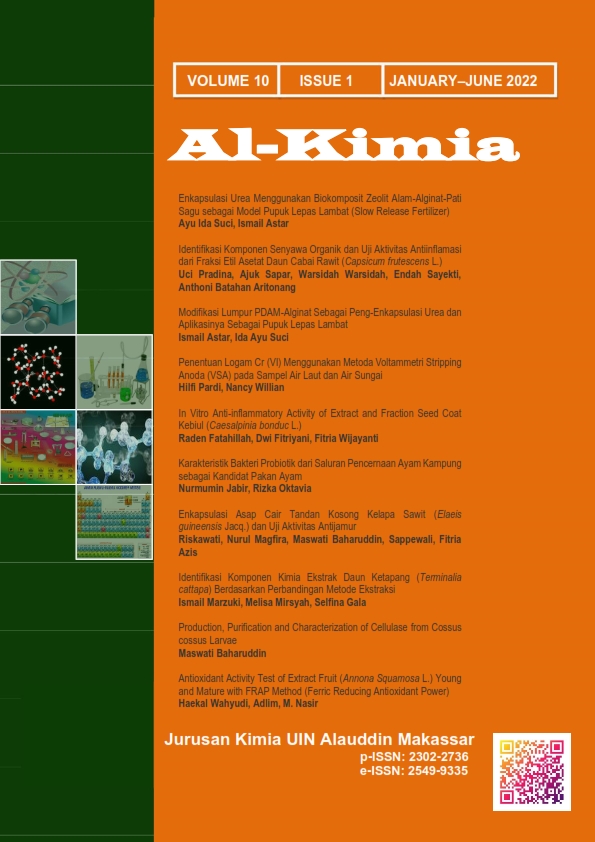Enkapsulasi Asap Cair Tandan Kosong Kelapa Sawit (Elaeis guineensis Jacq.) dan Uji Aktivitas Antijamur
Abstrak
Oil palm empty bunches is lignocellulose that can be processed into liquid smoke with the content of acid compounds and phenol compounds that function as a natural preservative. The purpose of this study to find out the characteristics of liquid smoke, see the effect of encapsulan on the liquid smoke encapsulation process, and see the antifungal activity of A. flavus and A. niger. The method used is pyrolysis process at a temperature of 400 oC to produce liquid smoke and encapsulation process by using variation of coating material using spray dryer with micro sized result. The result showed that the liquid smoke characteristics can be seen from its chemical content that is the dominant phenol compound and has the highest phenol content among the parts found in oil palm that is 68,15%. Based on analysis it can be seen that the best encapsulation process is by the addition of chitosan on maltodextrin with water content 5.78%, phenol content of 43.03 ppm and has a high rate of encapsulation efficiency of 45.87%. The liquid smoke microcapsules could inhibit the growth of fungi with the highest value of liquid smoke concentration, that is 3% with inhibitory value of 8.30 mm.
##plugins.generic.usageStats.downloads##
Referensi
Ariestya, D. I., Swastawati, F., & Susanto, E. (2016). Antimicrobial Activity of Microencapsulation Liquid Smoke on Tilapia [Oreochromis Niloticus (Linnaeus, 1758)] Meat for Preservatives in Cold Storage (± 5 C°). Aquatic Procedia, 7, 19–27. https://doi.org/10.1016/j.aqpro.2016.07.003
Ariyani, D., Mujiyanti, D. R., Umaningrum, D., & Harlianto, Y. A. (2015). Studi Kajian Kandungan Senyawa Pada Asap Cair dari Sekam Padi The Study Of Compounds In The Liquid Smoke From Rice Husk Dahlena Ariyani , Dwi Rasy Mujiyanti , Dewi Umaningrum Yuda Arimba Harlianto. 3–4.
Asmawit, A., Hidayati, H., & Supriyatna, N. (2011). Pemanfaatan asap cair dari tandan kosong kelapa sawit pada pengolahan karet mentah. Biopropal Industri, 02(01), 7–12.
Carneiro, H. C. F., Tonon, R. V., Grosso, C. R. F., & Hubinger, M. D. (2013). Encapsulation efficiency and oxidative stability of flaxseed oil microencapsulated by spray drying using different combinations of wall materials. Journal of Food Engineering, 115(4), 443–451. https://doi.org/10.1016/j.jfoodeng.2012.03.033
Darmadji, P., Saloko, S., Setiaji, B., Pertanian, F. T., Mada, U. G., & Mada, U. G. (2012). Inovasi prototipe produk nanoenkapsulasi biopreservatif asap cair sebagai pengawet pangan alami. 62–68.
Fitriani, S., Raharjo, R., & Trimulyono, G. (2013). Aktivitas Antifungi Ekstrak Daun Kedondong (Spondias pinnata) dalam Menghambat Pertumbuhan Aspergillus flavus. Lentera Bio, 2(2), 125–129.
Hu, Y., Zhang, J., Kong, W., Zhao, G., & Yang, M. (2017). Mechanisms of antifungal and anti-aflatoxigenic properties of essential oil derived from turmeric (Curcuma longa L.) on Aspergillus flavus. Food Chemistry, 220, 1–8. https://doi.org/10.1016/j.foodchem.2016.09.179
Kamal, N. (2012). Karakterisasi dan Potensi Pemanfaatan Limbah Sawit. Itenas Library, 61–68.
Ningsih, L. S. (2011). Pembuatan Asap Cair dari Sekam Padi dengan Proses Pirolisa untuk Menghasilkan Insektisida Organik. Jurnal Teknologi Pertanian Andalas, 01(No. 2), 23.
Oramahi, H. A., & Diba, F. (2013). Maximizing the Production of Liquid Smoke from Bark of Durio by Studying its Potential Compounds. Procedia Environmental Sciences, 17, 60–69. https://doi.org/10.1016/j.proenv.2013.02.012
Oramahi, H. A., Diba, F., & Wahdina. (2011). Antifungal Activity of Liquid Smoke from (Acacia mangium WILLD) and (Vitex pubescens VAHL) Wood Wastes. Bionatura-Jurnal Ilmu-Ilmu Hayati Dan Fisik, 13(1), 79–84.
Yuliawaty, S. T., & Susanto, W. H. (2015). Effect of Drying Time and Concentration of Maltodextrin on The Physical Chemical and Organoleptic Characteristic of Instant Drink Noni Leaf (Morinda citrifolia. Jurnal Pangan Dan Agroindustri, 3(1), 41–51.
Yusa Ali, D., Darmadji, P., & Pranoto, Y. (2014). Optimasi Nanoenkapsulasi Asap Cair Tempurung Kelapa Dengan Response Surface Methodology Dan Karakterisasi Nanokapsul. Jurnal Teknologi Dan Industri Pangan, 25(1), 23–30. https://doi.org/10.6066/jtip.2014.25.1.23
Authors who publish with this journal agree to the following terms:
1) Authors retain copyright and grant the journal right of first publication with the work simultaneously licensed under a Creative Commons Attribution License that allows others to share the work with an acknowledgement of the work's authorship and initial publication in this journal.
2) Authors are able to enter into separate, additional contractual arrangements for the non-exclusive distribution of the journal's published version of the work (e.g., post it to an institutional repository or publish it in a book), with an acknowledgement of its initial publication in this journal.
3)Authors are permitted and encouraged to post their work online (e.g., in institutional repositories or on their website) prior to and during the submission process, as it can lead to productive exchanges, as well as earlier and greater citation of published work (See The Effect of Open Access).


